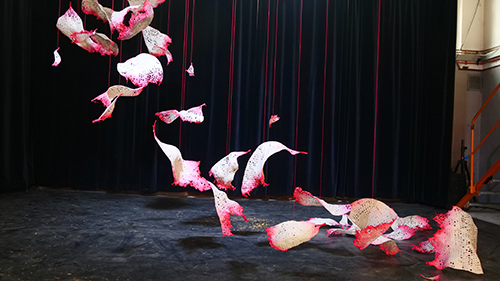
Download Image: Web
The Lycoming College Art Gallery will welcome Kristen Tordella-Williams, an interdisciplinary artist and arts educator based in the American South. Her exhibit, titled Fallen Lines, will premiere on Friday, Nov. 19, at 5:30 p.m., with a gallery talk, and will run into the new year until Jan. 22. The event is free and open to the public.
Fallen Lines is an installation of handmade paper sculptures, unique screenprints, performance documentation, and vinyl signage made primarily during the artist’s six week residency in Germany at the Ateliers im Alten Schlachthof in May and June 2021. The second spring she experienced in the Donautal (the Danube River valley) was lush with promise as the population slowly emerged from strict lockdown in Sigmaringen, the small southern city whose landscape and history inspired the work seen in Fallen Lines.
Frühlingsglaube is an installation of falling petals, flayed skin fragments, or insect wings tumbling through the air. Made from rabbit fencing, paper pulp, and tinted with red ink, the installation captures the fleeting beauty of springtime when petals fall softly to the ground and connects to the tentative hope felt while emerging from the long dark COVID winter. The paper installation flutters to the ground and transects both gallery spaces.
Frühlingsglaube roughly translates to a belief or hope felt as a result of spring. The title is from a romantic Friedrich Uhland poem of the same name, describing the fleeting beauty of spring and the hope that springs from the changing of the seasons. The spring of 2021 was an opening up of human activity after long lockdowns and pandemic restrictions. The beauty of blossoming trees is ephemeral and is all the more beautiful for its fleeting nature. The long dark pandemic winter and the overarching sense of doom led to all the more precious awakening. The use of red and abstract petal or wing forms as installed in a former slaughterhouse visually connects to flayed skin, bloody edges, and organic floral edges as found on a crepe myrtle or a linden tree. Caught in suspended animation, Frühlingsglaube captures the moment of transformation from life to death.
Floral shadows and insects intersect with the poems silkscreened on translucent silk handkerchiefs in the print series Spring Timelines. German writer Gabriele Loges, the Schlachthof residency board member and host, was an incredible resource and inspired research into 18th and 19th century romantic poems written in the Donautal on the topic of ephemeral spring and comparable poems in English that were incorporated into Spring Timelines. The consistent topic of spring connects through all the poems, some more laudatory and others critical. Insects appear in repeated patterns intertwined with poetry text printed in the artist’s handwriting. The floral imagery was made from capturing the shadows of the flowers around Sigmaringen and edited into mirrored compositions or single silhouettes. Displayed in a ray of red clotheslines, the printed handkerchiefs flutter in the breeze, delicately transparent and layered.
Also featured in Fallen Lines is the documentation of a performance made in collaboration with German musicians Michael T. Otto and Philippe Wozniak. Pollination Ceremony features a fülhorn (cornucopia) inspired floral sculpture from leftover rabbit fencing and kozo. During the performance, the artist pollinates an audience in the Schlachthof courtyard with dried marigold petals sprinkled from the fülhorn while live trumpet and upright bass play over a prerecorded score of spoken text from the poems, insect noise, heartbeats, and additional sound. Pollination occurs around us almost invisible but essentially keeping our world verdant and alive. Pollination Ceremony is an awakening, a fertilization of our imagination and ability to gather in celebration, creativity, and joy.
The final work, Signals II: Infestation, features brightly colored adhesive vinyl signs of enlarged insect life swarming along the gallery walls. Macro lens photos of insects collected by the artist at her home and abroad were used to create custom adhesive vinyl signage. Scaling up the insects from tiny flies, bees, or wasps, makes visible the hidden behaviour and insect life that awakens in the spring and signals the changing of the seasons. The use of primary colors and signage material draws viewers’ attention to the activity around them and combines industrial human activity with the smallest creatures that share the planet alongside us. Some of the insects appear dead while others are active in flight, drawing our attention to the abundant life that our planet hosts but often goes unnoticed.
While originally presented in Germany, the work in Fallen Lines is installed in response to the Lycoming College Art Gallery’s unique architecture by Tordella-Williams. Responding to the new gallery space, Fallen Lines presents the ephemera and timeless themes of changing seasons using industrial processes like screenprinting, materials like chicken wire, and the artist’s labor in an interdisciplinary exhibition and installation.
Tordella-Williams is a contemporary carpetbagger who was raised in Massachusetts, lived and worked in Jackson, Miss., for seven years, and is now an assistant professor of sculpture at Auburn University. Her research focuses on the impact the past has on our present through labor both personal and communal. She re-interprets materials commonly found in recycling bins, hardware stores, visual archives, and nature as remnants of our labor and explores issues of social justice, identity, gender, and memory manifest in these works.
The Lycoming College Art Gallery, located in downtown Williamsport at 25 W. Fourth St., contributes to the city’s arts culture and allows the College to become more involved with the surrounding community. Lycoming art students have the opportunity to interact with visiting artists and learn first-hand the inner workings of an art gallery.
The gallery is open Thursdays, Fridays, and Saturdays from 4-8 p.m. For more information, please visit the gallery online at: https://www.lycoming.edu/art/gallery/20-21.aspx.